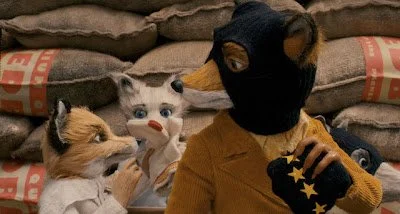
"Your tractors uprooted my tree.
Your posse hunted my family.
Your gunmen kidnapped my nephew.
Your rat insulted my wife —
and you shot off my tail.
I'm not leaving here without that necktie!"
— Mr. Fox, Fantastic Mr. Fox (2000)
The auteur theory asserts that filmmakers can be considered authors through producing a body of work illustrating a unique style and worldview. Here I discuss 2 Wes Anderson films that grant him the title.
The Royal Tenenbaums and Fantastic Mr. Fox seem to, at first glance, tell two distinct stories — one of a wealthy human family in a retro cityscape, and the other an animated adventure with creatures in (or underneath) the idyllic countryside. What defines Wes Anderson as an auteur, however, is how these films are not unlike each other at all.
Both plots revolve around morally questionable patriarchs who abandon their duties in pursuit of selfish rewards, leaving family and community to suffer from their recklessness, and ultimately finding redemption only through understanding others. Blinded by desire, both Royal Tenenbaum and Mr. Fox repeatedly disappoint those around them, until they finally grasp the necessity of responsibility and listening. Each film offers a more grounded, emotionally present mother figure as a foil—Etheline and Mrs. Fox—while the sons, Chas and Ash, wrestle with the wounds of paternal neglect. Even the children often emerge as the most mature voices, from the precocious Tenenbaums to Ash’s quietly capable cousin Kristofferson.
Stylistically, both works bear Anderson’s unmistakable signature: bold colors, crisp typography, and immaculate framing. The live action dazzles with its autumnal palette of browns, yellows, and reds, just as the stop-motion radiates with warm, textured tones. Both films open with punchy text that feels like the start of a storybook, followed by vibrant title cards that divide the tale into chapters. Music enters immediately as well—The Royal Tenenbaums with its wistful 70s pop, Fantastic Mr. Fox with rustic instrumental jingles—different in genre but equal in their power to immerse us in mood and place. Anderson’s gift for mise-en-scène is ever present: subjects and props positioned with meticulous symmetry, profile shots that isolate characters in frame, long takes that sweep across spaces—whether in the animal burrows underground or the aftermath of Eli’s crash above.
What animation brings Anderson is not limitation but freedom. His auteur style flourishes in the handcrafted details, where storyboards become production itself. In stop-motion, every element is sculpted and posed to his exacting vision, producing imagery that feels picturesque and alive. The smallest details hum with motion—fur bristles, teeth chatter, dust vibrates in the stillness—ensuring that even static moments carry a sense of dynamism. Animation allows him to transcend the constraints of live action, creating a storybook world where his fastidious artistry can breathe in full.
Wes Anderson’s auteurism reveals itself in Fantastic Mr. Fox from the very first frolic across the fields between Mr. and Mrs. Fox. Instantly, his trademarks appear: the warm, autumnal palette of browns and yellows echoing the fur of the foxes, the long tracking shot laterally following them through multiple picturesque locations that are shown like stage backdrops, objects meticulously spaced in parallel to create symmetry, and banjo-heavy folk music that pulls us into their rustic adventure. Within minutes, Anderson’s unmistakable touch radiates through aesthetic choices alone. Yet his style extends beyond visuals, it arrives in moments of thematic weight.
One of the film’s most striking scenes arrives when Mr. Fox encounters a wolf, the very creature he fears most. Hoping for dialogue, he is met instead with silence. The wolf stands dignified and aloof, silhouetted against a stark white peak, visually severed from Mr. Fox and his companions nestled in their cozy yellow-toned world below. With little left to say, Mr. Fox raises a fist; the wolf returns the gesture. Tears well in Mr. Fox’s eyes, and from this near-wordless exchange emerges a profound truth that resonates across Anderson’s body of work: live where you are meant to live, and be who you are meant to be. In Mr. Fox’s case, he finally understands his obligation to his domestic life — a revelation as moving as it is understated.







